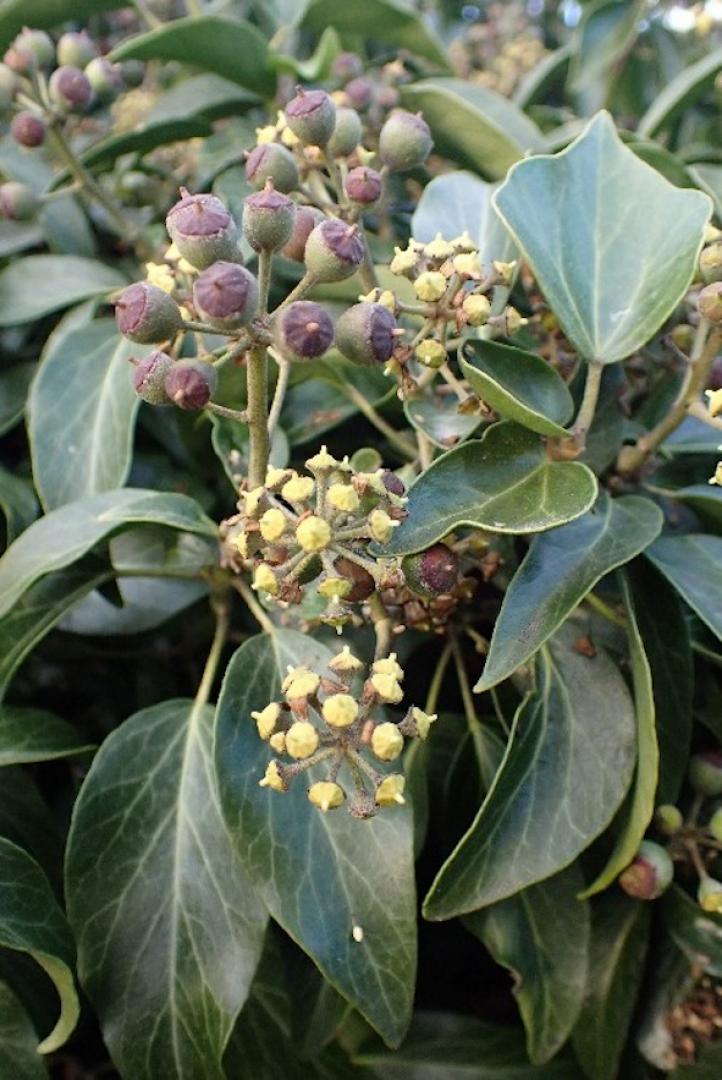Common ivy
A poisonous, evergreen shrub, common ivy can scramble up trees to reach considerable heights with the help of numerous short roots positioned along the stems.
The leaves are thick, evergreen and shiny, arranged alternately. The vegetative non-flowering shoots have more palmately lobed leaves, often marbled with prominent veins. The leaves on the flowering shoots are much less lobed and do not root along the ground in the same way.
Hairs present on the leaves and young stems are diagnostic for the different species in the family. In the common ivy, Hedera helix, they are stellate and whitish.
The yellowish green flowers are tiny but very attractive and worthy of closer inspection. Insects, attracted by large amounts of nectar crawl all over the umbel, cross pollinating the flowers.
After the anthers have released their pollen, they drop off and then the female stigmas become receptive to the pollen from other younger flowers, thus preventing self-pollination.
After fertilization, flowers develop into small black berries which are high in fat. Ivy is one of the last species to flower in the year, the berries still present at the end of winter.
The nectar, pollen and berries provide nutrients to many animals, including black caps, wood pigeons, numerous species of bees, wasps, hoverflies and their larvae. Blackbirds greedily eat the black berries in late winter. The dense, heavily intertwined branches also offer shelter to many insects, birds and small mammals. Ivy is a member of the family Arialiaceae with two subspecies native to the UK – Hedera helix ssp. helix and Hedera helix ssp. hibernica. Sub species Hibernica does not climb but spreads out over the ground.
Garden varieties of ivy include many originating from other countries which show great variability in leaf colour, shape and patterning.
Many cultures have adopted customs associated with ivy, from Ancient Greek and Roman times onwards.
When the god Dionysus was born, ivy was woven around his cradle as a guard against the magic of his wicked stepmother Hera. Consequently, Dionysius was often depicted with images of ivy in ancient Greek and Roman artworks where it came to represent fertility and eternal life.
Another old custom was to decorate the home with ivy in winter. As an evergreen, the ivy remains green, signifying eternal life. The greenery was thought to freshen the air and remind us of the coming spring. Growing ivy on the outside of your house was regarded as a deterrent against bad luck which might explain its presence on many old houses.
In contrast to this custom, ivy was said to bring bad luck if brought into the house any time other than Christmas. Even then it must be brought in along with holly, which was thought to counteract any negative magic that the ivy may have brought in with it.
Although poisonous, a very good reason not to go any further with it, in my opinion, ivy was used in herbal medicine and as a folk remedy.
The treatment of rheumatism and various external skin problems including verrucas was a common use. Saponins and other compounds present in ivy have been used to treat internal parasites and fungal infections.
Lizzie Maddison
Upper Teesdale
Botany Group
ADVERTISEMENT
Flora and fauna: Goodbye and good riddance to bad luck
ADVERTISEMENT
ADVERTISEMENT
ADVERTISEMENT







